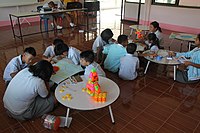
Photo from wikipedia
The use of machine learning techniques to predict material strength is becoming popular. However, not much attention has been paid to instance-based learning (IBL) algorithms. Therefore, in order to predict… Click to show full abstract
The use of machine learning techniques to predict material strength is becoming popular. However, not much attention has been paid to instance-based learning (IBL) algorithms. Therefore, in order to predict material strength, as the direct method by conducting tests is time-consuming and expensive and experimental errors are inevitable, an indirect method based on elementary instance-based learning algorithm was proposed. The standard k-nearest neighbors (k-NN) with cross-validation were utilized to develop compressive strength prediction models for some concretes and rocks by considering indirect parameters such as physical and mechanical parameters. Results on applying this method to datasets from literature studies show that the values of RMSE for k-NN are modest, indicating adequacy to predict compressive strength with comprehensive range values of predictors. Additionally, the R2-values of the k-NN models were high. In other words, the models were able to explain the variance in compressive strength for data with a wide range of input values.
Journal Title: Advances in Civil Engineering
Year Published: 2021
Link to full text (if available)
Share on Social Media: Sign Up to like & get
recommendations!